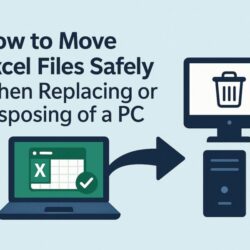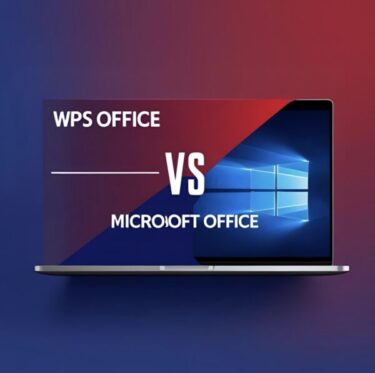
A step-by-step guide to prevent “can’t open,” broken formatting, and macro failures
- 1 Who this is for
- 2 TL;DR — Quick Checklist (do these on the old PC first)
- 2.1 1) Inventory first: make the invisible visible
- 2.2 2) On the old PC — pre-migration work (detailed steps)
- 2.2.1 2.0 Back up first
- 2.2.2 2.1 Convert legacy formats (.xls → .xlsx / .xlsm)
- 2.2.3 Batch conversion (optional, lots of files)
- 2.2.4 2.2 Macros & add-ins (VBA), 32/64-bit differences
- 2.2.5 2.3 Passwords & encryption
- 2.2.6 2.4 CSV: encoding, delimiter, and decimal symbol
- 2.2.7 2.5 External links, Power Query, ODBC/ACE
- 2.2.8 2.6 Fonts & layout
- 3 3) On the new PC — prep the environment
- 4 4) If it still won’t open or work
- 5 5) Suggested “Migration Rules” for small teams
- 6 6) Data protection when disposing of the old PC
- 7 7) Quick reference tables
- 8 8) Wrap-up
Who this is for
- Individuals and small teams replacing an old Windows PC
- Admins preparing multiple PCs for disposal or trade-in
- Anyone who hit “old Excel files won’t open in the new Excel” problems
TL;DR — Quick Checklist (do these on the old PC first)
- Convert .xls → .xlsx / .xlsm (remove Compatibility Mode)
- Migrate macros/add-ins (.xla → .xlam), record VBA References and bitness (32/64-bit)
- Re-save password-protected files with modern encryption
- Fix CSV issues: re-save as CSV UTF-8; confirm delimiter (comma/semicolon) and decimal symbol
- Note external links, Power Query sources, ODBC/ACE drivers, fonts
- Pilot test a few “representative” files on the new PC before decommissioning the old one
1) Inventory first: make the invisible visible
On the old PC, list what you actually use:
- Excel version (e.g., 2010/2013/2016/2019/2021/Microsoft 365) and 32/64-bit
- File types: .xls, .xlsx, .xlsm, .xla, .xlam, .csv
- Macros (VBA) and References (ADO/ODBC, COM libraries, external DLLs)
- Password/encryption usage
- External links (shared folders, network paths), Power Query data sources
- Fonts used in templates/reports
Tip: In File Explorer, search *.xls OR *.xla to surface legacy formats quickly.
2) On the old PC — pre-migration work (detailed steps)
2.0 Back up first
Copy working folders to an external SSD/HDD or a cloud drive. Spot-check a few files after copying.
2.1 Convert legacy formats (.xls → .xlsx / .xlsm)
Why: Old .xls increases failure rates on new Excel.
How: Open in Excel → File → Save As → choose Excel Workbook (.xlsx).
If the file contains macros, choose Excel Macro-Enabled Workbook (.xlsm).
Do this before moving files to the new PC. It removes Compatibility Mode issues early.
Batch conversion (optional, lots of files)
Use this VBA on the old PC to mass-convert .xls to modern formats (back up first!):
Sub BatchConvertXlsToXlsx() Dim fso As Object, folder As Object, file As Object Dim inPath As String, wb As Workbook inPath = InputBox(“Folder path to convert:”) If inPath = “” Then Exit Sub Set fso = CreateObject(“Scripting.FileSystemObject”) Set folder = fso.GetFolder(inPath) Application.ScreenUpdating = False Application.DisplayAlerts = False For Each file In folder.Files If LCase(fso.GetExtensionName(file.Name)) = “xls” ThenSet wb = Workbooks.Open(file.Path, ReadOnly:=False)If wb.HasVBProject Then wb.SaveAs Replace(file.Path, “.xls”, “.xlsm”), FileFormat:=xlOpenXMLWorkbookMacroEnabledElse wb.SaveAs Replace(file.Path, “.xls”, “.xlsx”), FileFormat:=xlOpenXMLWorkbookEnd Ifwb.Close SaveChanges:=False End If Next Application.DisplayAlerts = True Application.ScreenUpdating = True MsgBox “Done”End Sub2.2 Macros & add-ins (VBA), 32/64-bit differences
- In the VBA editor: Tools → References. Take screenshots of checked libraries.
- If moving from 32-bit to 64-bit Office, Declare statements may need PtrSafe and pointer types updated.
- Convert old add-ins .xla → .xlam. Store them in a Trusted Location (see 3.2).
2.3 Passwords & encryption
Old encryption schemes can block opening on new Excel. On the old PC:
Open → remove password → save in modern format → re-apply protection with the new Excel after migration.
2.4 CSV: encoding, delimiter, and decimal symbol
- Re-save as CSV UTF-8 to avoid mojibake across systems.
- Regional settings matter: some locales use semicolon as list separator and comma as decimal symbol.
- If needed, import via Data → Get Data → From Text/CSV to pick encoding and delimiter explicitly.
2.5 External links, Power Query, ODBC/ACE
- In Data → Queries & Connections, note each source path/server.
- If shared folder paths will change, plan the new UNC path (\\server\share\…).
- List required drivers (ODBC providers, Access Database Engine) and their bitness (32/64-bit).
2.6 Fonts & layout
If reports use non-standard fonts, install them on the new PC (license-permitting) or test suitable substitutes.
3) On the new PC — prep the environment
3.1 Install the right stack
- Office version and bitness (match your dependencies; 32-bit has broader add-in compatibility, 64-bit helps huge models).
- ODBC drivers / Access Database Engine (match bitness).
- Required fonts.
3.2 Trust Center, macro security, and “files from the internet”
Modern Office blocks macros from files downloaded from the internet. Options:
- Right-click the file in Explorer → Properties → Unblock (then reopen), or
- Place files in a Trusted Location: Excel → File → Options → Trust Center → Trust Center Settings → Trusted Locations.
3.3 Pilot test before decommissioning the old PC
Pick 5–10 “representative” workbooks: open → calculate → run macros → print preview.
Fix issues while the old PC is still available.
4) If it still won’t open or work
Open & Repair
File → Open dialog → pick the workbook → click the dropdown next to Open → Open and Repair.
Rescue with another engine
LibreOffice/Calc can sometimes open damaged or stubborn legacy files and export to .xlsx.
(Expect some formatting/macros to break—use as a last-resort bridge.)
Kill broken external links
Data → Edit Links (or Queries & Connections) → break/update links to the new path.
CSV imports still messy?
Use Data → Get Data → From Text/CSV and explicitly set encoding, delimiter, and decimal symbol.
5) Suggested “Migration Rules” for small teams
- Save formats: .xlsx / .xlsm only (ban legacy .xls going forward)
- CSV: default to UTF-8; document exceptions when partners require another encoding/delimiter
- Paths: use UNC paths (\\server\share\…) rather than PC names or mapped letters
- Acceptance test: every new PC validates 2–3 department “golden” files before go-live
- Ownership: appoint a macro/add-in maintainer; broadcast changes
By deciding these rules up front, small teams avoid one-off workarounds and keep migrations predictable, faster, and less error-prone.
6) Data protection when disposing of the old PC
- Windows Reset: Settings → System → Recovery → Reset this PC → Remove everything → choose the option to clean the drive.
- SSD secure wipe (advanced): some SSD vendors provide utilities for Sanitize/Secure Erase or PSID Revert. Use with care and only if you understand the implications.
- HDD physical destruction (high-sensitivity data): degauss/shred through a certified recycler; obtain a Certificate of Destruction where required.
7) Quick reference tables
7.1 Migration task list (printable)
Excel Migration Task List
| Step | What to do | Why it matters |
|---|---|---|
| Backup | Copy folders to external/cloud and spot-check | Prevents data loss |
| Convert .xls | Save as .xlsx/.xlsm (remove Compatibility Mode) | Avoids “can’t open”/broken formatting |
| Macros/Add-ins | Record References; .xla → .xlam; plan 32/64-bit | Keeps VBA working |
| CSV | Re-save as CSV UTF-8; confirm delimiter/decimal | Prevents mojibake & wrong splits |
| External links | Note PQ sources, ODBC drivers, UNC paths | Stops link breaks |
| Fonts/layout | Install needed fonts or pick substitutes | Preserves look & printing |
| Pilot test | Open/calc/macro/print on the new PC | Finds issues while rollback is easy |
7.2 Which conversion method should I use?
Choosing a Conversion Method
| Method | Best for | Pros | Cons |
|---|---|---|---|
| Manual “Save As” | Few important files; careful review | Precise; check as you go | Slow for large volumes |
| VBA batch (sample above) | Many .xls files; limited time | Fast; consistent | Back up first; review output |
| Open in LibreOffice then export | Rescuing stubborn/damaged files | Can open what Excel rejects | Format/macros may degrade |
Pick the simplest method that fits your volume. Start manual for key files, then batch the rest.
8) Wrap-up
Most “new PC can’t open my old Excel files” stories are preventable.
Do the conversions on the old machine, document dependencies, then pilot on the new PC while rollback is easy.
Handle CSV and macro security consciously, and finish with a proper wipe before disposal.
✔️You might also find these helpful:
▶︎How to Fix “A Required File Is Missing or Corrupt” Error in Windows
▶︎What Is a Windows Installation Media? A Complete Beginner’s Guide to Creating and Using It


